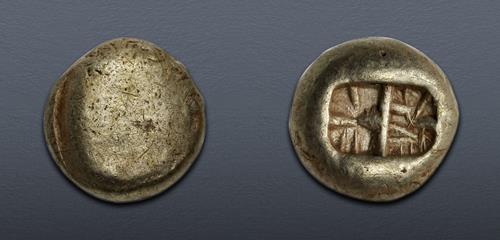|
IONIA, Uncertain. Circa 650-600 BC. EL Hekte – Sixth Stater (10mm, 2.39 g). Lydo-Milesian standard. Plain globular surface; traces of letters of an unknown script along part of edge / Incuse rectangle with geometric pattern. Triton XXIII, lot 387; CNG 115, lot 231; CNG 114, lot 323; CNG 112, lot 263–4; Heritage 3054, lot 30097; Heritage 3020, lot 24985; otherwise unpublished. Trace deposits, light marks/scratches. As made. Very rare.
From the Locksmith Collection.
This coin is from part of a recently discovered issue of inscribed hektai with a plain obverse and rectangular incuse on the reverse, the first of which was noted in a private British collection in 2011. The prior analysis of these coins has associated the issue with the ubiquitous plain obverse hektai of Ionia, suggesting that this inscribed version was perhaps a late issue in the production of that coinage, with struck dates suggested in the 660s and 640s BC. Admittedly, the form of this issue, and its metrology, do comport with the uninscribed plain incuse issues of that period. However, the peculiar reverse punch of this issue should not be overlooked. With regard to the complex varieties of early electrum, associations and relative chronologies are often established through reverse die linkages or similarities of idiosyncratic punch forms.
The rectangular punch used for this issue bears little resemblance to the two small punches used on the uninscribed plain hektai of the mid 7th century. The use of two small square punches, in fact, appears to have been a canonical aspect of not only the plain hektai, but also the ubiquitous striated electrum issues also dated to the 7th century, and even the contemporary royal Lydian hektai that circulated throughout the region. These small punches were also plain in appearance, devoid of any designs. These aspects suggest that the inscribed plain hektai are not closely associated to the uninscribed plain issues. Moreover, a small group of these inscribed coins was presented to a researcher, which was accompanied by a known Carian issue that dated to the early 5th century BC. The researcher noted the surfaces and fabric of the issues appeared highly consistent, suggesting they were part of a single hoard. This, in turn, suggested that these electrum coins were struck later than the 7th century, possibly as late as the end of the 6th century.
Turning to the inscription, elements of the letters appear similar to a number of glyphs in the various alphabets that were used along the coast of western Asia Minor. However, as a whole, the letters most closely resemble those found in the Carian alphabet (see Tables I and II in I.J. Adiego, The Carian Language [Brill: Leiden, 2007]), though the exact interpretation of legend remains uncertain. Before the discovery of the CNG 112, lot 263 coin, only the first three letters were visible. That said, the inscription may actually be even longer, as its visibility on the coins is hampered by the low relief of the letters and their position on the edge of the die.
The final winners of all Triton XXVI lots will be determined at the live public sale that will be held on 10-11 January 2023.
Triton XXVI – Session One – Lots 1-334 will be held Tuesday morning, 10 January 2023 beginning at 9:00 AM ET.
Winning bids are subject to a 22.5% buyer's fee for bids placed on this website and 25% for all others.
We recognize that our users may have various Internet Browsers and Operating Systems. We like our visitors to have the best possible experience when using our bidding platform. However, we do recognize that it is impossible to develop applications that work identically, efficiently and effectively on all web browsers. The CNG bidding platform supports the latest stable major version and stable previous version of Chrome and Firefox.
|
